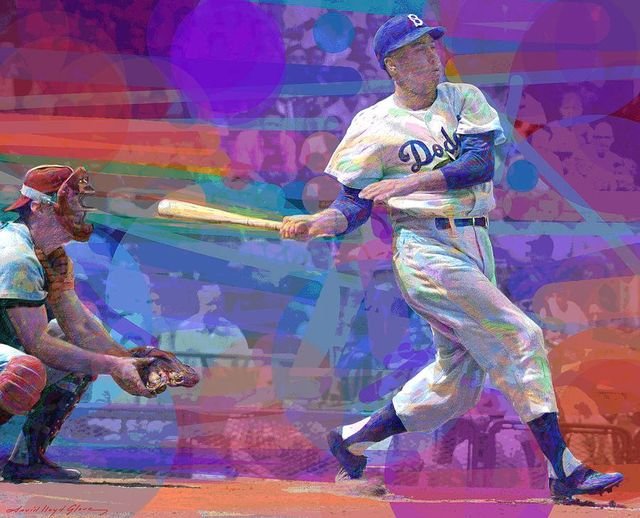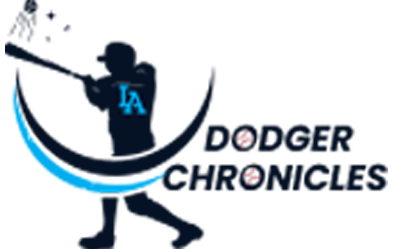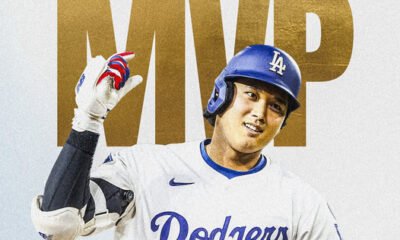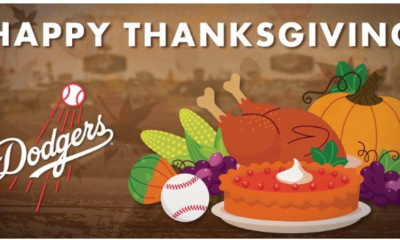
Just who are the top 10-hitters in Dodger history? There would be several formulas to use. Highest career BA as a Dodger, best OPS, highest offensive WAR. Myself, I think the minimum time spent as a Dodger has to be at least a decade. Some players had short career with the team and were very good. Some players who are at the top of the different categories might surprise some fans. For instance, the Dodgers all-time top position player WAR leader is…….Pee Wee Reese. Reese’s overall WAR is 68.4. In second place is Duke Snider, 65.3. But Duke’s offensive War is 68.1. 10 points higher than Reese’s 57.7. Willie Keeler, who produced a .352 career BA while a Dodger, is not on the top 10 WAR list at all.
Gary Sheffield, who spent a little over 3 full seasons in LA, leads in OBP, Slug and OPS. But if you look at players who spent more than just a couple of years with the Dodgers, Jackie Robinson is the OBP leader. Snider would lead in Slug and OPS. Shohei Ohtani had maybe the greatest offensive season any Dodger has ever had this year, but before that, it would have been the 1930 season compiled by Babe Herman. The highest single season BA ever by a Dodger at .393, and he didn’t even win the batting title. He finished second to the Giants Bill Terry who hit .401.
Most of us know that only 2 players in Dodger history hit over 300 homers while playing for the Dodgers. Duke Snider with 389 and Gil Hodges with 361. The most by an LA Dodger is Eric Karros with 270. To put that in perspective, the current LA leader is Max Muncy with 190. Max should join Garvey Cey and Kemp as one of the hitters with over 200 with LA. Mookie in his five seasons has hit 132. Ohtani is the only Dodger ever to top 50. Snider had more 40 or more seasons than any other Dodger, 5.
Trying to pick a top 10 is difficult. In this era, OPS is king. Since players rarely spend 10 years with a single team anymore unless they are superstars, I will go with what seems to be about the average length of time one spends, six years. Especially with free agency. And to keep it fair, I will list the top 10 in each offensive category. Then after, we can try to sort out those who were really outstanding hitters.
Offensive War
In order, with their numbers, Snider 68.1, Reese 57.7, Robinson 54.5, Wheat 54.3, W. Davis 41.4, Hodges 40.3, Cey 40.0, Gilliam 37.7, P. Guererro 36.7, Dixie Walker 33.2. That Snider tops the list is not a surprise. Duke would have probably ended his career with a .300 BA, but injuries his last few years took their toll. The surprise to me is Pee Wee. Reese was a .269 career hitter. He did not have a lot of power, but he was a stolen base threat in his time. He did finish with 330 doubles and 80 triples. I was also surprised to see Hodges down so far on the list and Campy not in the top 10. Of course, all of these numbers are when they were Dodgers. Mike Piazza, who’s career WAR is 59.5, is tied with Garvey at # 11, 32.8. Garvey’s career WAR is 38.0.
Career BA As a Dodger
B. Herman .339, Piazza .331, Wheat . 317, Mota .315, Robinson .311, Walker .311, Guererro .309, Frederick .308 Reiser .306, Daubert .305. Tommy Davis finished in LA with a .304 BA. Willie Keeler, Jack Fournier, and Harry Hendrick, all finished with averages above Wheat’s .317, but none played more than 4 years with the Dodgers. Mota 13 and Garvey, played longer in LA than most. Wheat played 18 years for Brooklyn.
OPS As a Dodger
Piazza .966, Herman .953, Snider .936, R. Smith .915, Guererro .893, Robinson .883, Seager .870, J. Turner .865, Campy .860, Hodges .847. Betts is right behind Smith at .902 and will be on the list after next season which will be his sixth. Freddie is right behind Snider at .919. But he still has 3 years left on his deal which will bring him to exactly the six-year mark. Muncy is .004 behind Hodges. He is in his seventh year. Just for a reference, the single season mark was set by Herman in 1930. 1.132. Ohtani’s 1.036 is eighth.
Hits & Total Bases While a Dodger
Hits: Wheat 2804, Reese 2170, W. Davis 2091, Snider 1995, Garvey 1968, Russell 1926, Furillo 1910, Gilliam 1889, Hodges 1884, Wills 1732. Total Bases: Wheat 4003, Snider 3669. Hodges 3357, W. Davis 3094, Reese 3038, Garvey 3004, Furillo 2922, Karros 2740, Gilliam 2530, Russell 2471.
Doubles-Triples-Homers
Doubles: Wheat 464, Snider 343, Garvey 335, Reese 330, Furillo 324, W. Davis 321, Gilliam 304, Ethier 303, Karros 302, Hodges 294 Triples: Wheat 171, W. Davis 110, Hy Myers 97, Jake Daubert 87, Thomas Burns 85, John Hummel 82, Snider 82, Reese 80, Tom Daly 76, Jimmy Sheckard 76 Homers: Snider 389, Hodges 361, Karros 270, Campanella 242, Cey 228, Garvey 211, Kemp 203, Furillo 192, Muncy 190, Piazza 177. If Muncy hits his yearly average, which is 34 for a 162-game season, he would slide in right behind Cey after next season. Betts will still be behind Piazza, he would be in the 160 range, but by the end of his career, he is certainly capable of hitting more than 300 with the years he has left on his deal. Ohtani could become the first Dodger to hit 400 homers as a Dodger. As long as he is healthy for his next 9 seasons.
Runs Batted in as a Dodger
Snider 1271, Hodges 1254, Wheat 1210, Furillo 1058, Garvey 992, Karros 976, Reese 885, Campy 856, W.Davis 849, Cey 842. Hodges drove in 100 or more 7 times, Snider 6, Garvey and Karros did it 5 each. Mike Piazza did it 4 of his six full seasons as a Dodger. He just missed the other two years.
Extra Base Hits Total
Snider 814, Wheat 768, Hodges 703, W.Davis 585, Karros 582, Garvey 579, Furillo 572, Reese 536, Eithier 499, Kemp 476. Mookie and Shohei at some point will be on this list. Shohei had 99 last season alone. Mookie averages around 80 per season. Freddie is usually around 89 or so. But with only 3 more years left on his deal, and the fact that he will be 37 when his contract is up, he will probably not average that many every year.
Runs Created
This stat to me at least, seems to be more important that some might think. After all, the aim is to outscore your opponents. Wheat 1446, Snider 1405, Hodges 1211, Reese 1135, Furillo 1006, Gilliam 984, W.Davis 971, Garvey 966, Robinson 955, Karros 880. The players at the top of this list spent 10 years or more with the team. Wheat was a Dodger for 18 seasons. Jackie Robinson only had a 10-year MLB career.
Over the years, the Dodgers have had some very good hitters. Some would excel in all facets of hitting. The players from the early days tended to strike out a lot less than players today. In his 18 seasons in the majors, Duke Snider struck out more than 100 times only twice. DiMaggio never struck out more than 39 times in an entire season in his career. But striking out now does not carry the stigma it did in those years.
Over all the years I have been watching the game I always felt the best hitter I saw in a Dodgers uniform was Mike Piazza. Piazza could hit for average and power. He had amazing power the other way. I used to see him hit balls over the right center field fence a lot. Right now, the best pure hitter on the team would to me be Freeman. Freddie uses the entire field. Mookie is a much better hitter when he uses the entire field too. But sometimes he gets pull happy and rolls over on the ball a lot. Freeman on the other hand can take that outside pitch and scorch one to left.
Zack Wheat had to be fun to watch. Hitters in that dead ball era had a totally different hitting philosophy. Guys like Willie Keeler, the Waner brothers, and of course, Ty Cobb. I loved watching Tony Gwynn hit, George Brett too. But the way the game is played has changed a lot. In some ways, the old game was much better. Hitters made contact more often. But when your team is winning, you tend to overlook some of the warts.
Born June 14th, 1948, in Los Angeles California. AKA The Bear













Cubs are set to DFA Patrick Wisdom. They have a trade with the Guardians in the works to acquire reliever Eli Morgan. Morgan had a 1.93 ERA in 42 innings of work last year for Cleveland. Wisdom had a bad year last season, but the prior three years he slugged 20 or more homers. Rockies re-signed C Jacob Stallings for one year.
Good stuff Bear, as usual. I agree that Freddie is our best “pure” hitter. I love his approach and use of the whole ballpark.
The other day Badger had a list of suggestions for pitchers to address injuries “Grips, off speed, command, strength and conditioning, added recovery time, less work load. You can still throw 98, but only on occasion and make sure it at least flirts with the strike zone.” Great list and i agree with everything except “less workload”.
I think we can all agree that arm injuries are a crisis. 37% of active major-league pitchers have had Tommy John surgery, and that doesn’t include a variety of other arm- and shoulder-related ailments. While the percentage is in part a testament to the advancement of surgical procedures and rehab programs, the alarming figure speaks to the increased stress on pitchers.
This is bad for the game. And in some ways it’s abuse of a player. Pitchers are encouraged to throw as hard as they can, for as long as they can. When they blow out it’s next the man up and the game moves on. While that kid’s future is sacrificed.
The process isn’t sustainable. The Dodgers and other teams are spending time and resources exploring what can be done. A change in pitching philosophy will be hard, change is hard. And change in routines in baseball is especially hard.
I have some ideas. Some are better then others but I’m tossing out ideas to consider.:
As medical science and procedures improve, it’s easy to just go about business as usual. When an elbow blows up they can come up with improved procedures. Maybe insert a steel cable or bracing procedure. Fix em up and send them back to the front.
This doesn’t involve any change of philosophy or reduction of maximum velocity and spin. The scouts and coaches don’t need to adjust their thinking.
The gap between a pitcher’s maximum four-seam fastball velocity and his median is shrinking. Pitchers appear to be going all out more often and leaving a smaller variance in their range of pitch speeds.
Changing the emphasis from maxing out on every pitch would be a major deviation from the norm in today’s game. As the game has evolved from pitchers pacing their effort to pitch 9 innings, the standard for a quality start is 4 or 5 innings. Two times through the order.
Is there really a desire to change that? Do the analytical guys really think it’s a good idea to extend starters to pitch deeper into games. That’s another organizational philosophy change.
The emphasis on scouting has been to find young talent that throws hard. What’s the first thing you see behind the backstop when scouts gather at a game? Radar guns.
When you listen to scouts describe a young pitching prospect, the first information after the kid’s name is “92-94”, or some numbers that start with a 9, meaning velocity numbers. First thing.
Danny Litwhiler is generally credited with adapting the modern radar guns to baseball. Litwhiler was the coach at Michigan State in 1973, and when he saw campus police using radar to time speeding cars, he quickly understood that the devices might be applied to baseball. Litwhiler saw it mostly as a teaching tool, one that would allow his pitchers to measure the velocity difference between their fastballs and changeups. Litwhiler understood almost immediately that the radar gun could be revolutionary. He wrote to MLB Commissioner Bowie Kuhn in hopes of alerting all major league teams, and he traveled to spring training in 1975 to show it off to big league managers, coaches and executives.
Some veteran scouts moan about the tendency to classify pitchers simply by how hard they throw, but every team requires scouts to list velocity on every report.
I ran the bullpen for some scout’s try-out camps in the 2000’s and I was told to select only pitchers who threw 90+. 89 and less, there was no interest.
So, I don’t think this will EVER change. Velocity and spin will still be king. That won’t change. I see no interest in some device or brace that reduces velocity, strapped to a pitcher. Kind of a “restrictor plate” in NASCAR to limit speed.
What needs to change is how pitchers are taught and what’s expected. Learning to conserve effort and leaving something in the tank becomes the focus again. How to get hitters out with stuff is a major departure from what is now emphasized. And again, do teams want to change that and have pitchers conserve energy to go deeper into games? Is there value in having pitchers learn this art of pitching to have them go 5 innings?
These are the questions that have to be addressed by every organization and disseminated throughout the personnel of the entire organization.
That’s a huge task.
Along the way, I have some other possible changes for pitcher’s health and performance:
Some of this is old school and science has pooh-poohed some of this ideas. But arm injuries are ruining the game. So let’s look at everything.
While I’m at it, I have some other suggestions to address in the offseason:
That’s enough from me, for now. Respectful opinions on my thoughts are welcomed.
I’m for doing away with pitch framing (cheating). Great now they want more stolen bases, but lets do away with that mitt that makes runners fingers longer
Framing isn’t cheating. It just isn’t.
You can appreciate the skill when you see the difference between a good, subtle framer and a lousy one.
At any rate, the framing issue becomes moot with a robot ump.
Yeah, the sliding mitt needs to be limited.
The biggest problem in your list as I see it is the pitchers are now asked to go max out on every pitch, and not pacing themselves. It used to be that pitchers had no problem going thru the lineup a 4th time. They knew how they pitched the hitters 1st, 2nd, and 3rd time thru. They held enough back to get thru the lineup at least three times. If you are going balls to the wall on every pitch, it is not hard to see why today’s pitchers have problems getting thru 5 innings and often times get hurt.
I also agree with you that pitchers are not adequately stretched out in MiLB.
I love the use of a tackified ball as they use in Japan.
One area of disagreement – Refrain from signing pitchers with arm injuries. If the Braves followed that, they would not have the current CY candidate, Chris Sale. It will be hard to fill a pitching staff without pitchers with an injury history. The favorite for the AL CY is Tarik Skubal. He has had TJ surgery (college) and two significant stints on the 2022 (63 days) and 2023 (96 days) IL due to arm injuries.
My thought on your 363 double play a runner is automatically out when he’s out of the baseline No Matter What the situation is.
I like an idea stolen from the game of Rounders in that situation. Just drill the baserunner in the back and he’s out.
I think that play is so beautiful. It should be awarded 2.5 outs.
As Jeff D alluded to the Baseball America top 10 is out. ($$$$$)
https://www.baseballamerica.com/teams/2012-los-angeles-dodgers/prospects/?season=2025
Ad Josh Norris mentions, its “really, really good.”
Morales doesn’t make top 10, nor does Swan, Harlan, Ko or George!
Rushing at the top.
Vargas at 9
The new draft pick at 7, seven hitters in top 10.
Alex Freeland has jumped Josue De Paula to move up to #2. De Paula dropped one spot to #3 and Zyhir Hope moved up to #4. LHSP Jackson Ferris moved to #5. OF Eduardo Quintero and SS Kellon Lindsey remained at #6 and #7. Justin Wrobleski dropped a few spots to #8, and SS Joendry Vargas and RHP River Ryan round out the top 10.
Landon Knack dropped out of top ten and replaced by Jackson Ferris.
Good stuff. Thanks for heads up.
Love the love for Freeland!
His potential may be what precludes us from signing a SS to a long term deal (unless it’s Adames and he’s willing to shift to 3b soon)
Freeland supposedly has a good arm and could also play third base if Adames signs here, so they’d have a choice.
Two small anecdotes:
DePaula may not be a lost cause defensively to the team, they had Heyward work with him.
in the chat today the name Sammy Sanchez came up! Love that name!
Bear thanks for a great Dodger post. The Duke was my greatest hitter but i understand the Piazza choice.
Duke was a great hitter, but his career BA is just under .300. LA fans did not get to see him at his best. But he is still the only Dodger to have 5 40 HR seasons in a career, and he did it 5 straight years. Ohtani has a chance to do that.
No surprise, Sale wins NL Cy Young award. Jamaii Jones signed a minor league deal with the Tigers. Former Dodger prospect was traded to the Yankees early in 24. Also, no surprise, Skubal wins the AL Cy Young. Trivia, when was the last season that they awarded just one Cy Young for both leagues? And who was the last pitcher to get the single award????
Jahmai Jones was originally a top Angels prospect–first or second round, I think– who was traded to the Orioles for SP Alex Cobb. (An opinionated Dodgers blogger we all know once claimed the Angels “gave up” on Jones, but the Halos got a frontline starter for him. That is not “giving up.” That was a smart trade.)
Anyway, the Dodgers invited Jahmai to spring training a couple seasons back, but he got screwed.
Fans here should remember how the brass seemed strangely hellbent to rebuild the middle of the infield with Lux at SS and Miguel Vargas at 2B. Their misguided faith in Vargas seemed to ignore his underwhelming debut the previous season, when the brass also strangely decided that he had earned a spot on the postseason roster.
So Jahmai, Luke Williams and another guy all got short shrift while the job was basically gift-wrapped for Vargas–even though Vargas was LEARNING the new position and was struggling to come back from hand injuries.
Meanwhile, Lux blew out his knee, so Rojas took over SS–thank goodness–while we waited for Vargas to bat .300 and live up to the hype.
But Vargas’s vaunted bat ever really showed on the ML level. On defense, he was a disappointment (though the blogger who dissed Jones called it “stellar.”)
Ultimately, Vargas was shipped back to OKC.
Meanwhile, both Jones and Williams were still playing in the majors–Jones with the Brewers, Williams with the Braves.
Whenever fans insist that Friedman is infallible, remember that he apparently thought the keystone combo of Lux and Vargas was a winning formula. Wrong and wronger. Vargas’s failure came fairly quickly; about a year would pass and the brass fortunately found a taker in the White Sox. I think it’s fair to say the Dodgers “gave up” on Vargas, because he had so many chances to prove himself.
Lux played his way from SS to 2B the next spring. I don’t think the Dodgers have given up on him at all. But with Mookie likely to move to 2B, Lux should be traded.
How about Lux + Wrobleski for Devin Williams?
‘66 Koufax
I still believe an in depth scientific study needs to be done on “recovery” from overload. (The overload principle is you do as many as you can then you do one more) I saw a YouTube piece done by a guy named Ryan quoting several strong sources saying that for every 24 pitches thrown a pitcher needs 24 hours recovery. A pitcher throws 75 pitches, he requires 75 hours of recovery. This was for youth baseball but seeing what we’re seeing I think a strong argument could be made that it applies to young professionals as well and I would like to see someone make that argument.
Soto would be a huge addition at a needed position, but bringing Hernandez back, then signing Adames and Sasaki would have a greater impact at the same combined cost or less.
Rob Manfred feels Roki Sasaki will be posted after Dec 2, so he’d be in the 2025 international class:
https://www.espn.com/mlb/story/_/id/42513454/roki-sasaki-likely-part-25-international-amateur-class
Not ideal for the Dodgers, but given how much of other teams’ allocation is already “promised.” For the Dodgers, it’s a good thing MLB owners are honorable.
LOL
Alas, how far has Newsweek fallen.
https://www.newsweek.com/sports/mlb/this-blockbuster-dodgers-white-sox-trade-sends-50-million-star-los-angeles-1989181
I would do that trade immediately though I would hate to give up Morales.
On a side note: On ESPNs website they still have up the GAme 5 result of the WS but they only have us up only 1-0 in the series. 😀
Go Dodgers!!!!!!!!!!!!
There’s zero chance you would do that trade.
What about it appeals to you?
Robert jun. solves our problem in CF. One of the best defenders in t he game regardless of position.
Still young and 2 more years on a cheap contract. Excellent power if he is not injured. With him in CF we can put Edman at ss and have no need to sign Adames to a huge contract.
Yes, injury history is a bit concerning.
Benintendi has had a rough stretch but as a Nr. 4 or 5 outfielder he is okay.
Go Dodgers!!!!!!!!!!!!!!!!!!!!!!!!!!!
Burnes and Robert Jr appeal to me.
Why are people like this?
Over at Dodgers Digest, Dustin Nosler offers a thorough “offseason plan” that would essentially “run it back” by working deals to bring back free agents Teo, Kike, Treinen and Buehler, and make a significant addition in Adames.
His trade proposal for Crochet: Bobby Miller, Dalton Rushing, Jeondry Vargas and Oswaldo Osorio.
The White Sox might do that. It was reported that they were insisting on Rushing in talks last season. But I think the Sox need so much help they might be tempted by a bigger package.
Instead of Rushing, how about Cartaya plus Outman? They’d get a catcher and a outfielder who was finished 3rd for ROY in ’23.
Would Lux be of interest?
Just don’t want to deal Rushing before we can see what he can do. He can start out in a platoon with Pages, and get action at C and 1B. If he doesn’t wind up at catcher, he might be Freddie’s successor.
Like most folks, Nosler assumes that Sasaki will be a Dodger.
I’m having doubts about that.
Sasaki might prefer the Dodgers for the familiarity provided by two Japanese teammates. But would he want to be in Shohei’s shadow? Or would he earn more in endorsements as a bigger fish and a different big pond?
I hate that package for Crochet. Way too much IMHO.
Rather have one of the free agent LHP like Snell.
Go Dodgers!!!!!!!!!!!!!!!!!!!
That may look like a lot to a Dodger fan, but I could see Chicago fans thinking it’s not enough. A broken pitcher and a handful of prospects. And Dodger prospects at that. I think including Lux and Outman, maybe a guy like Knack or Casparius with those A players would interest them more. Of course Jr must come with him. And yeah, Benintendi can come back. He’s only 30. He can be fixed.
A lot of rumors have him going to San Diego, which is the last place I want to see him go.
Even if Sasaki gets posted after Dec.2nd I still see the Dodgers being the front runners for him. Only small market teams will have more money available from the pool than the Dodgers. And it is not significantly more money .
For me it comes down to the question where Sasaki wants to play for the next years. If he wants to come to the Dodgers a little less money upfront will not make the difference.
With endorsements via the Dodgers he probably will make more money than with any ohter team in MLB.
If he goes to SD I will be really disappointed. Would be huge lift to the Padres and if Sasaki is right he will be a true ace starter we´d have to face often.
Go Dodgers!!!!!!!!!!!!!!!!!